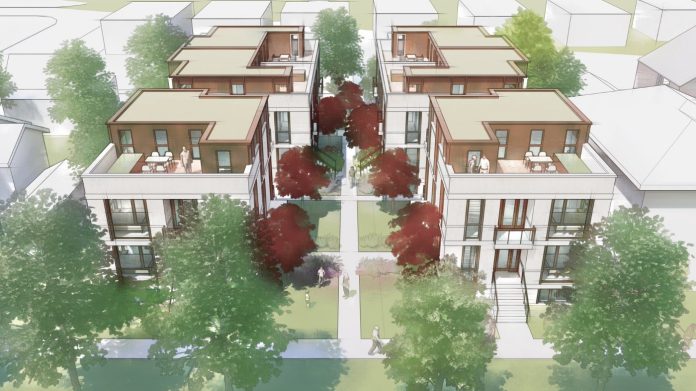This is probably the first of a series of articles specifically looking at “Single Family” zoning in Seattle and how we pivot to smarter growth patterns for our exploding population, cut the high cost of housing, employ necessary strategies for climate change, and reverse the inequity baked into our city’s lowest density zones.

1. Revise Single Family Zone setbacks. Reduce the front setback to ten feet and side to zero. All other things being equal, this change would push new development toward the street, concentrate shadows to the front half of lots and leave more contiguous, outdoor space in back for recreation, gardening and big trees. Side yards account for 20% of any given 100-foot deep 5,000-square foot lot, yet add little usable function. Zero lot line development, at 30-foot and 40-foot height limits, defines a very comfortable feeling streetscape, enclosed but not stifling, like the rowhouses and walkups built before larger footprint lots and detached houses became the American norm. The exact rollout of this idea would require a lot of study to get at the urban form Seattleites would want.
2. Regulate building form not number of units. Zoning and fees should be based on square footage. We can build for more households at a lower per unit cost, without overwhelming the existing neighborhood context if we’re solving for total volume rather than unit count. Building more smaller homes per lot reduces the cost per home, which in turn opens the door to a more socioeconomically diverse neighborhood where people have more choices in the type of home they’d like to live, and be closer to amenities like parks and transit that we already have.
When we focus on unit counts for revenue, it inhibits some number of units. For example, residential impact fees can add up fast. Redmond charges nearly $5,000 per multifamily unit, which is enough to make developers build less units at higher price point–a double whammy for modest, more affordable housing.

3. Increase number of attached units allowed under Seattle Residential Code from two to four, before requiring more expensive to satisfy Seattle Building Code (SBC). The SBC drives up construction cost for sprinklers and mechanical requirements. I know this stands zero chance of happening, but I have to include it in here–we are seeing clients who’d like to build two accessory dwelling units, but don’t because of the real cost of jumping to SBC compliance.
4. Allow Mom’n’Pop commercial uses, such as professional offices, cafes, corner stores and daycares, and give them a presence in the front yard near the sidewalk. One shouldn’t have to get into a car to do quick everyday errands. Plus, small commercial spaces are great for entrepreneurs starting up new ventures, or internet businesses that don’t require a lot of physical space to operate. In a COVID-19 city, remote work is going to replace many large common offices, and little spaces sprinkled through the city are going to be in high demand.
5. More incentives for stacked flats through floor area ratio, lot coverage, and a higher threshold for entering design review to make them pencil. Educate builders, banks and buyers about how to successfully develop co-ops. Reform our condominium laws with common sense protections for consumers and limits of liability for builders. It would open up a new whole market of small scale development to buyers who’d never otherwise afford or want a stand alone house, plus serve those for which climbing stairs isn’t practical like our upcoming ‘silver wave’ of downsizing Boomers.

6. Prioritize investments in social infrastructure in historically underserved parts of the existing city with more parks, schools, transit, trees, urban agriculture, food options, health and cultural venues, gathering spaces, and sidewalks, rather than on undeveloped land or augmenting more affluent quarters. A complete neighborhood has one of everything, but inflexible zoning creates everything of just one type–detached houses. Let culture and community happen by making it easier for neighborhoods to fill in the gaps.

7. Rebalance the right-of-way. Reduce road width for cars and add space for bikes, pedestrians, street trees, and stormwater infrastructure. COVID-19 has shown us that: 1) it is possible to envision a post-car city, and 2) that the benefits for health and the environment are real once we change our behavior. There are large parts of the city that as yet don’t even have sidewalks, so the opportunity to make more multi-modal streets is still available.
8. Make every house Passivhaus. All new residential construction should meet the Passivhaus standard for low energy use, thermal comfort, and airtightness. It is based on solid building science, results in higher performance structures that are more durable and use less energy every day for their entire lifecycle. It isn’t a far cry from where our energy code will eventually go, but why wait? The systems, materials, and details are being used worldwide, and entire countries, such as Belgium, mandate quality buildings under the Passivhaus standard.
9. Reward the creation of additional units with extra floor area ratio and/or lot coverage. Portland’s Residential Infill Project is an excellent template for trading additional square footage for extra units. Seattle has a similar incentive with accessory dwelling units not counted toward floor area ratio. We should go further and pair additional principal units with a larger total buildable footprint and/or floor area. The mechanisms of the zoning code should push new projects to take full advantage of scarce land and available development capacity.
This is a cross-post from Matt Hutchins’ personal blog on Medium.

Matt Hutchins
Matt Hutchins is an advocate for housing abundance, smart growth and sustainable architecture. As a Principal at CAST Architecture, he is working on innovative housing options, from cottages to co-housing.

